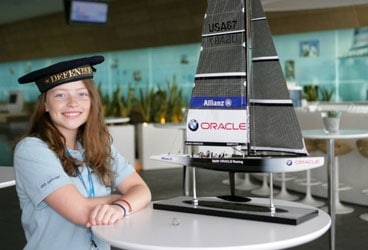
NBRing
The ring that Alison Turner carried from Deer Isle, Maine, to Valencia, Spain, does not look like much to fuss over. It is a simple, dull grey metal hoop, bent around in a circle. It carries no jewels or embellishments, save the scratches and scars of long use. Yet, it is a precious heirloom and a powerful America’s Cup link between the past and the present. Its legacy spans more than 100 years, reaching down from 1895 when a yacht called Defender lived up to its name and defended the America’s Cup against a British challenger called Valkyrie III – the ninth successful defence since 1851 in what was to become a 132-year winning streak by the New York Yacht Club.The ring belonged to Charles Scott, Alison’s great, great, great grandfather who was a crewman on Defender in 1895 and on the next defence campaigner, Columbia, in 1899. When Defender was scrapped, its aluminium hull was melted down and each of the crew received a simple ring as a memento. As far as is known, only two or three of these rings survives today, and Alison’s has been handed down in her mother’s family through the generations.Alison visited BMW ORACLE Racing – the sole team campaigning to return to the America’s Cup to the USA -as part of a group of teachers and students from the remote fishing community of Deer Isle-Stonington. Their mission: to research an extraordinary connection with the America’s Cup and, for several of them, to discover personal ties to the event they never knew about.Back in the late 19th century, the early America’s Cup defenders relied heavily on professional seamen, many of them from Scandinavia, Norway in particular. In 1895, the New York Yacht Club entrusted the management of its defence campaign to C. Oliver Iselin and urged him to fill the crew positions not with foreigners, but with “proper Yankees” in the words of Tom Duym, one of the teachers accompanying the group.”As far as we can make out, Iselin used to summer in Maine,” said Duym. “He would see these lobstermen out in their small Friendship sloops racing each other back to harbour. They had a reputation for being great seamen and so he sent Captain Henry Haff up to Deer Isle to recruit them for the America’s Cup.”Haff met with Captain Fred Weed – another of the group, teacher Torri Weed Robbins, believes she is a descendant. Weed obliged by handpicking the entire working crew of Defender from his fellow islanders. Charles Scott, Alison’s ancestor, was one of them. “It is pretty exciting to make the connection from over 100 years to the present,” said Alison, “and to compare how they used to race then and how they do it now. It is completely different.” Alison said she only sails “infrequently”, but added this America’s Cup project might change that.So successful was the Deer Isle crew in 1895 that the defenders turned to them again for the next campaign in 1899. “There were more than 200 applications,” said Duym, who is a marine trades teacher in the Deer Isle-Stonington school system.Billy Billings is another student in the group. “I wasn’t aware that I had any family connections with the America’s Cup before this project started,” he said. He has, in fact, found multiple connections from both the paternal and maternal side of his family. John Billings was on both the Defender and Columbia campaigns, while Eben, Monteford and one other Haskell were also part of the Deer Isle Boys story.Like his ancestors, Billy Billings is a lobsterman. In fact, Duym says one of the astonishing things about the Deer Isle Boys project is the revelation that not much has changed in the past century. The principal activity remains lobster fishing and “the character of the people from Deer Isle would not be much changed from before. They are extremely competitive, independent and value hard work. Lobster boat racing remains a popular pastime, although nowadays it is diesel powered rather than sail driven.”By the time the project ends, Duym said, the students will have created a multimedia documentary, book and play incorporating what they have learned. It is too soon to know, though, exactly what shape the project’s end product will assume. “We’re building the plane as we’re flying it,” he said.The highlight of the project was unquestionably the visit to Valencia, said teacher Anne Douglass. “It is wonderful to be here. We are still pinching ourselves that it has actually happened.”Two factors made the visit possible. When the school contacted BMW ORACLE Racing and described the project, the team immediately invited a group to come to Valencia for a first-hand experience of modern America’s Cup campaigning. To make the trip, however, they had to find funding and were given great assistance by Bill Whitman, a New York Yacht Club member, keen sailor and a descendant of Deer Isle settlers from 1801. He not only made a generous contribution, but accompanied the group himself. Like Alison, he brought a memento as well in the form of a sailors hat, emblazoned with the name Defender in gold letters.The cap, which usually resides in the Deer Isle-Stonington Historical Society, belonged to Roscoe Fifield. Fifield was a Deer Isle Boy who crewed on Defender and Columbia and from whom Whitman is directly descended. “It is very exciting for the school to discover this heritage and get right into this project,” said Whitman, who traveled to Valencia with the school group and with his son Fife – short for Fifield, of course.









